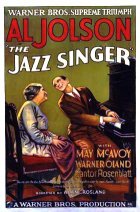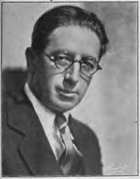
The Jazz Singer Page #4
- UNRATED
- Year:
- 1927
- 88 min
- 1,327 Views
He takes a fresh grip on the boy and starts in the direction of the
bedroom.
78.FULL SHOT ROOM
As father with son in tow go toward the bedroom, the mother follows a
few steps, pleading with the cantor not to whip Jakie. He turns around
and demands what she means by such interference. She looks at him
imploringly.
79.CLOSE-UP SARA
She holds out her outstretched hands to the cantor, saying:
TITLE 22:
"It will do no good, Papa -- and he must getready for school in a few minutes. Yom Kippur
begins soon."
80.CLOSE SHOT GROUP
The cantor answers her with a snort of disgust and renewed determination
to continue with what he considers his duty. The boy, emboldened by his
mother's championship, turns and faces his father courageously. The old
man looks down at him in surprise.
81.CLOSE-UP CANTOR AND SON
The boy looks up at his father, his boyish face set with determination.
He declares:
TITLE 23:
"I told you before -- if you whip me again,I'll run away -- and never come back."
At this show of rebellion the cantor stiffens. He nods his head
menacingly as though accepting the challenge, takes another grip on the
boy's shoulder, and pushes him toward the bedroom, as Jakie starts
sobbing hysterically. At the door, the cantor takes a strap that is
hanging over a chair near the door.
82.MED. SHOT ROOM
As the cantor shoves open the door, Sara again tries to intervene. The
cantor holds out a hand to prevent her following, pushes Jakie into the
bedroom, and follows him, closing the door behind him with a bang. Sara
stands looking tearfully at the door, realizing the expected crisis in
the little family, which she has feared, has finally arrived.
83.CLOSE-UP SARA
She stands mutely facing the door. Suddenly she starts and listens, then
puts her hands over her ears as though to shut out the sounds she hears,
and her shoulders heave with repressed sobs. She starts for the door,
then restrains herself. Her emotions finally overcome her and she drops
into a chair and cries without restraint. (Nothing of what occurs in the
bedroom is shown.)
84.MED. SHOT SAME
The door of the bedroom opens suddenly and Jakie emerges. He is shaking
with a mixture of anger and the painful effects of the whipping. He
comes out quickly, looks at his mother, rushes over, and kisses her
impulsively, and as she puts her arms around him, he breaks away and
before she can stop him, he runs toward the front door.
85.FULL SHOT ROOM
Jakie rushes to the door and dashes out, as the cantor appears in the
doorway of the bedroom. He is somewhat breathless from exertion. He does
not look to see what has become of the boy. He pauses and looks at his
wife in a dazed way. He looks toward the door. Then in a mechanical way
he takes his watch from his pocket and glances at it.
86.CLOSE-UP CANTOR
He holds the watch up to his eyes closely, then looks in the direction
of his wife and says:
TITLE 24:
"It is time for the services, Mama."He turns to the wall behind him where hangs the prayer shawl and the
freshly washed and ironed robe which the cantor wears when he sings the
"Kol Nidre" on the Day of Atonement.
87.MED.SHOT BOTH
The cantor starts putting on the robe, with great deliberation. Sara is
standing mutely looking toward the door through which her boy vanished.
FADE OUT:
FADE IN:
88.INT. SYNAGOGUE LONG SHOT
Every pew in the place is filled with men, and in the balcony behind sit
the women in the place reserved for them. On the raised platform, the
cantor and the choir boys are taking their places.
89.CLOSE SHOT CANTOR AND CHOIR
As the boys line up, a solemn look on each young face, the cantor looks
from one to the other.
90.CLOSE-UP CANTOR
He has his back to the congregation. He has his eyes fixed on the place
where Jakie usually has stood.
91.MED. SHOT
As the Cantor stands motionless, the rabbi steps up to him. The old man
looks at him and they exchange a few words.
92.CLOSE SHOT BOTH
The cantor looks at the vacant place again, then turns to the rabbi and
says, with a break in his voice:
TITLE 25:
"Tonight my boy Jakie was to sing 'Kol Nidre'-- but he is not going to be a cantor now."
Back. He finishes title. The rabbi moves out of scene, and the cantor
takes the position in which he is to sing.
93.FULL SHOT SYNAGOGUE
The congregation comes to attention, and small groups that have been
conversing look toward the cantor.
94.MED. SHOT CHOIR
The cantor is in the foreground, his back to the camera, as the first
low notes of the "Kol Nidre" are sung. Never has the cantor's voice sung
the heart-breaking song like this before. There is a tear in every note,
and as his voice rises in the wailing harmony that is handed down from
the walls of Jerusalem, the choir boys look at him in wonder. (Vitaphone
is used in full volume.)
95.FULL SHOT SYNAGOGUE
As the cantor's voice rises in a long, mournful wail, the scene and
music slowly FADE.
TITLE 26:
Ten years and three thousand miles away fromthe ghetto.
FADE IN:
96.AIRPLANE VIEW OF SAN FRANCISCO
A shot may be obtained which immediately identifies the city, with its
hills and ferries and the Golden Gate in the distance.
DISSOLVE INTO:
97.OFFICE STAR VAUDEVILLE CIRCUIT
Full shot of room shows various types of performers seated about the
room awaiting an opportunity to talk to the booking manager. There is an
old-time legitimate actor of the East Lynne period, a dancing team of
girls, three Teutonic-looking acrobats, a fat young man whose clothes
were once quite "snappy," and a few other types found usually in such a
place. The fat man is hidden behind a copy of Variety. An office boy,
small, weazened, and wise beyond his years, pertly tells all inquirers
that Mr. Schuler is "in conference." All of the people in the room look
hopefully toward the door every time it is opened and look away
hopelessly every time it closes. A big, husky, flashily dressed blonde
enters and breezes up to the boy. He gets up and tries to hold the gate
of the enclosure shut, so that she cannot enter.
98.CLOSE-UP BLONDE AND BOY
She says that she is there to see Mr. Schuler. The boy looks at her and
says:
TITLE 27:
"Mr. Schuler's in conf'rence and can't be disturbed."The girl gives him a supercilious look, shoves him aside, and sweeps up
to the door to the inner room. She opens it and passes in as the boy
stands with open mouth and gazes after her.
99.FULL SHOT ROOM
The less fortunate performers sit and look wonderingly at the closed
door. The boy finally shrugs his shoulders and takes his chair. The
outer door opens and a young man enters. He is shabbily dressed and,
although he is neat of person, it is obvious that he is down on his
luck. He pauses and then hesitatingly goes up to the railing where the
office boy sits idly hammering a typewriter with no paper in it. The boy
doesn't even look up.
100.CLOSE-UP JACK
He stands looking at the boy nervously.
TITLE 28:
It was a long jump from Jakie Rabinowitz toJack Robin -- and the roses in his pathway
Translation
Translate and read this script in other languages:
Select another language:
- - Select -
- 简体中文 (Chinese - Simplified)
- 繁體中文 (Chinese - Traditional)
- Español (Spanish)
- Esperanto (Esperanto)
- 日本語 (Japanese)
- Português (Portuguese)
- Deutsch (German)
- العربية (Arabic)
- Français (French)
- Русский (Russian)
- ಕನ್ನಡ (Kannada)
- 한국어 (Korean)
- עברית (Hebrew)
- Gaeilge (Irish)
- Українська (Ukrainian)
- اردو (Urdu)
- Magyar (Hungarian)
- मानक हिन्दी (Hindi)
- Indonesia (Indonesian)
- Italiano (Italian)
- தமிழ் (Tamil)
- Türkçe (Turkish)
- తెలుగు (Telugu)
- ภาษาไทย (Thai)
- Tiếng Việt (Vietnamese)
- Čeština (Czech)
- Polski (Polish)
- Bahasa Indonesia (Indonesian)
- Românește (Romanian)
- Nederlands (Dutch)
- Ελληνικά (Greek)
- Latinum (Latin)
- Svenska (Swedish)
- Dansk (Danish)
- Suomi (Finnish)
- فارسی (Persian)
- ייִדיש (Yiddish)
- հայերեն (Armenian)
- Norsk (Norwegian)
- English (English)
Citation
Use the citation below to add this screenplay to your bibliography:
Style:MLAChicagoAPA
"The Jazz Singer" Scripts.com. STANDS4 LLC, 2025. Web. 23 Feb. 2025. <https://www.scripts.com/script/the_jazz_singer_878>.







Discuss this script with the community:
Report Comment
We're doing our best to make sure our content is useful, accurate and safe.
If by any chance you spot an inappropriate comment while navigating through our website please use this form to let us know, and we'll take care of it shortly.
Attachment
You need to be logged in to favorite.
Log In